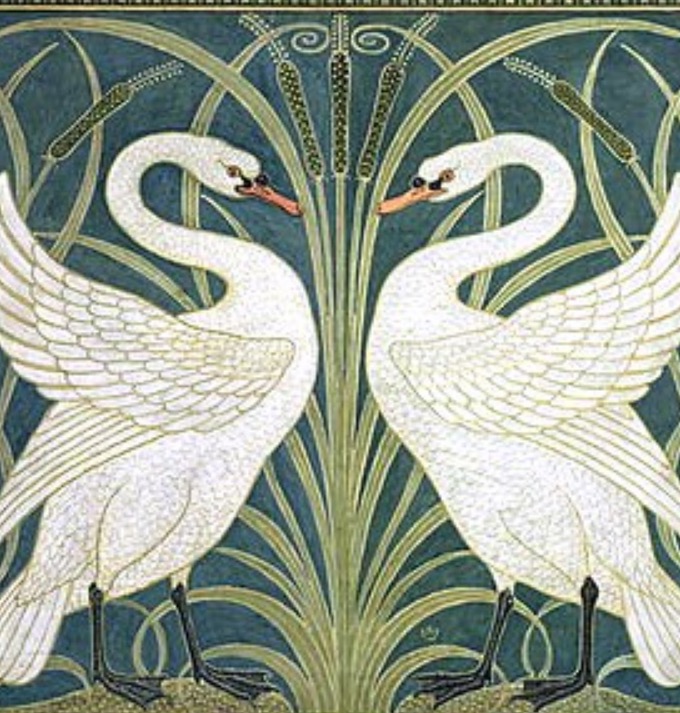
To begin, Art Nouveau artists fought against the idea that fine art, painting, and sculpture should be considered superior to the decorative arts. Art Nouveau designers created aesthetically pleasing products intending to improve people’s lives by incorporating art into the mundane. Art Nouveau adherents, like those of the preceding Arts and Crafts movement, believed that works of art should be both aesthetically pleasing and well-crafted. Furniture, silverware, architecture, paintings, graphics, jewelry, fashion, and glassware are examples of where fine art and applied arts began to blend. Art Nouveau rejected historicism and emphasized formal invention, and so it became a transitional movement from Victorian design to the modern art movements of the early 20th century.
Art Nouveau Artists & People You Should Know About
(Olbrich had designed the Secession's exhibition building three years before.) Like the Secession building, the Ernst-Ludwig-Haus is highly rectilinear, with a gleaming white exterior capped by a gently sloping roof, set on the brow of a hill. This is offset by the arched, centrally-located main entrance, delineated by its gold-plated, cloudlike geometric pattern surrounding the doorway, which is fronted by Ludwig Habisch's twin male and female sculptures personifying Strength and Beauty. Although the Colony only lasted until the outbreak of war in 1914, today the structure serves as a museum of their artistic endeavors.
The Poster is a visual history of one of the most powerful and memorable means of mass communication - Creative Boom
The Poster is a visual history of one of the most powerful and memorable means of mass communication.
Posted: Fri, 18 Sep 2020 07:00:00 GMT [source]
Related Artists
Some assume the lady may represent Klimt’s close friend and partner, Emilie Floge. Others believe that she resembles Red Hilda, the model who sat for Klimt’s Woman with a feather boa, Goldfish, and Danae. The gallery is supported by towering oak columns that are, in turn, supported by massive beams that create a rhythmic division of the room, resulting in an atmosphere of unparalleled harmony. The 13 lights clustered in the center of the room and hung from the ceiling by tendril-like wires create a specific visual link between the actual space and the idea of the tree of knowledge. Throughout his career, Mackintosh employed the image of a tree as a motif in almost all of his creative endeavors. Mackintosh and his wife Margaret Macdonald, his friend Herbert MacNair, and Frances Macdonald (who was married to MacNair), were collectively referred to as “The Four” because of their close working relationship.

The Barbizon School Art Movement: History, Artists, Artwork
A dominant sphere in which the art nouveau style can be seen is within architectural design. Blending ornament and structure, this style incorporated a number of different elements – for example, glass, ceramics, brickwork and iron. Another key characteristic of this style is the use of bold outlining together with delicate hand-illustrated typefaces and designs. The overall approach to art nouveau aimed to honour the unique forms, shapes and themes that exist in nature in a way that is increasingly romantic and whimsical!
Artist or Maker
This genre of art allowed not just the wealthy to access the beautiful things in life but bring beauty into spaces everyone could enjoy, adding functional purpose, from architecture and interior design to graphic arts, jewellery and much more. Many of the artworks in Art Nouveau were not paintings (which would often only be attainable for the rich), but objects of use such as vases, chairs, lamps and buildings. The artist-designer Jules Chéret (1835–1932) was a notable early creator of French Art Nouveau posters.
Art Nouveau poster designers, especially in the earlier years, had to work with the early technology of lithography, which in early versions limited the number of colors they could use. They are also very much influenced by Japanese prints, especially those of Hiroshige, with their flat planes and two dimensions, which were being popularized expositions in Paris during this period. Students are trained in print and publication design; web and interface design; motion graphics for broadcast and film; branding, identity and type design; as well as for careers in design history and education. In 1888 Morris decided to establish a printing press to recapture the quality of books from the early decades of printing.
At least as much as it was prominent on outside facades, Art Nouveau was closely involved with interior design, much like the Victorian style revivals and the Arts and Crafts Movement. Like these other 19th-century architectural movements, Art Nouveau’s interior design aimed to create a unified, cohesive space that used every surface. It can still be seen in many buildings, from massive institutional and commercial structures to modest row homes. Particularly in building, Art Nouveau artists sought to use a broad range of idioms was used to highlight Art Nouveau.
These lines were used to represent the natural curves found across nature – as seen in the curves of grapevines and branches. Art Nouveau, also translated as “New Art”, was an art movement from the late 19th century to the early 20th century that influenced the fields of art, architecture, applied arts, and decorative arts. Beginning in England with William Morris, word soon spread about the Art Nouveau movement and how it was transforming the art world.
Alphonse Mucha was a spectacular illustrator who had expanded the horizon of Art Nouveau. His story of becoming the artist he’s known as today is inspiring and all too familiar for the starving artist. Below are some of the unique posters and magazine covers that came forth during the period of early printing. If you observe nature closely, you’ll notice there isn’t much symmetry as everything around it evolves and takes a natural course rather than a predefined one. Being partly inspired by Romanticism, it was common to see intertwined motifs to represent femininity, more specifically the curls of hair in depictions of women.
The widespread acceptance of Art Nouveau across the world proves that traditional barriers have been successfully broken down between artistic disciplines. By Overcoming neoclassicism’s reign in the arts, the movement inspired creatives worldwide to enhance the quality of everyday life via the enhancement of architecture, interior design, and consumer goods. When speaking of graphic design, Aubrey Beardsley can be deemed one of the first graphic artists of the Art Nouveau style. Aubrey’s illustrations made their way to book cover design with his most famous works being for the Salome by Oscar Wilde and Le Morte d’Arthur (The Death of Arthur) by Sir Thomas Malory. Its main aim was to move away from traditional forms of art and in doing so, they took inspiration from the natural organic lines and forms seen in nature. The Art Nouveau style is quickly recognized due to its long flowing lines, asymmetrical layouts, and in architecture, its use of industrial materials.
However, it was revitalized in the 1960s and is today seen as a key predecessor to, if not a core component of, Modernism. Mackmurdo’s woodcut demonstrates the impact of English design, namely the Arts and Crafts movement, on Art Nouveau. The title page, which Mackmurdo created in the same manner as later European Art Nouveau designs, has intricate interactions between positive and negative space, visual rhythms, and abstract patterns inspired by the development of plants.
Reed was fond of combining floral motifs with sensitive portraits of young and at times cheeky women, not a few of them based on self-portraits. Eugène Grasset’s poster for his exhibition at the "Salon des Cent" in Paris features a personification of the Arts engaged in the attentive study of a plant called Bishopswort. The dark contour lines and expansive planes of color are reminiscent of stained-glass painting. In the 1860s he simplified the printing technique of lithography and established a fast and inexpensive printing process. As a designer, with his colorful compositions, he laid the foundations for the modern poster, intended to have an impact from a distance.
On his initiative, major artists were commissioned with poster designs, among them Henri de Toulouse-Lautrec, Théophile-Alexandre Steinlen, and Eugène Grasset. The Czech painter Alphonse Mucha is probably the most widely known Art Nouveau artist, with his poster artwork being an elegant symbol of cafe culture the world over. Mucha’s paintings have a very distinctive style which remains a popular influence for illustrators and graphic artists today. The art movement from Japan that influenced Art Nouveau the most was called ukiyo-e, which means “pictures of the floating world.” Ukiyo-e was the elaborate process of creating woodblock prints that created flat perspectives. The use of space, colour and decorative patterns used in Japanese artwork greatly inspired the same elements in Art Nouveau. From the seventeenth to the nineteenth century the academic world of the Arts was dominated by a hierarchy where Fine Art such as paintings and sculptures were seen as superior and therefore given more attention and opportunities.
His architectural works were mostly influenced by the principles laid down by Victor Horta. Horta had emphasized the use of the stem, and to ignore the flowers and the leaves, which was valuable advice that was reflected in Guimard’s designs. He had also influenced the works of Hector Guimard who went on to create one of the first Art Nouveau buildings in Paris and signage for the Paris metro. Victor Horta was a Belgian architect and one of the founders of the Art Nouveau movement. Many of his works represented the true Art Nouveau style and his Hôtel Tassel in Brussels is often cited as the first Art Nouveau house. Siegfried Bing, a German-French art dealer, introduced Japanese art to the West and this greatly contributed to the development of Art Nouveau design.
Articles with the “HISTORY.com Editors” byline have been written or edited by the HISTORY.com editors, including Amanda Onion, Missy Sullivan, Matt Mullen and Christian Zapata. The Federal Art Project of the Works Progress Administration (WPA) is also credited for spreading the Art Deco form in the United States with artists like Rockwell Kent, Diego Rivera and Reginald Marsh. Ukranian artist Cassandre specialized in transportation posters, most notably his 1935 poster of the French cruise ship Normandie, and is also known for his distinctive advertising work. Art Deco permeated people’s personal lives in its effect on furnishings and decorative items.

No comments:
Post a Comment